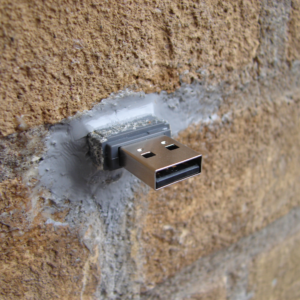 If you saw a USB plug sticking out of a wall, would you jack in?
If you saw a USB plug sticking out of a wall, would you jack in?
Who even uses the term “jack in” any more?
In 2010, artist Aram Bartholl launched his USB dead drops project. In five locations in New York City, you could find USB type A connectors sticking out of walls. There was no context or instructions. You walked up, connected, and found what there was to discover. Files? Art? Malware?
The term “dead drop” comes from the world of espionage. To avoid having to meet (increasing the chance of discovery) and preserve anonymity, spies would arrange to drop off files in secret locations: under a foot bridge, in the hollow of a tree in the woods, etc. If you want a master class in how these dead drops were used, see the arrest warrant application for US spy Philip Hanssen, who exclusively communicated with this Russian handlers via dead drops for decades without ever revealing his identity to those buying his secrets.
In theory, USB dead drops can function as anonymous, offline, peer-to-peer file sharing networks. As Bartholl explained in the Dead Drop Manifesto:
Dead Drops is an anonymous, offline, peer to peer file-sharing network in public space. Anyone can access a Dead Drop and everyone may install a Dead Drop in their neighborhood/city. A Dead Drop must be public accessible. A Dead Drop inside closed buildings or private places with limited or temporary access is not a Dead Drop. A real Dead Drop mounts as read and writeable mass storage drive without any custom software. Dead Drops don’t need to be synced or connected to each other. Each Dead Drop is singular in its existence. A very beautiful Dead Drop shows only the metal sheath enclosed type-A USB plug and is cemented into walls.You would hardly notice it. Dead Drops don’t need any cables or wireless technology. Your knees on the ground or a dirty jacket on the wall is what it takes share files offline. A Dead Drop is a naked piece of passively powered Universal Serial Bus technology embedded into the city, the only true public space. In an era of growing clouds and fancy new devices without access to local files we need to rethink the freedom and distribution of data. The Dead Drops movement is on its way for change!
Free your data to the public domain in cement! Make your own Dead Drop now! Un-cloud your files today!!!
Around the World
Bartholl’s project spread around the world, and to date over 1,400 dead drops have been recorded with 10TB of storage capacity. In theory, they can be used to exchange files that for various reasons would not be welcome on the public Internet – for example, activists or those trying to break free of government surveillance.
But let’s be honest – most of the drops are for hipsters, artists, and curious passersby.
If you search for “USB dead drop” you’ll see all kinds of howtos, articles, and blog posts from 2010 to about 2013-2014, but then they fall off dramatically.
But this subculture is by no means dead. If you look at the Dead Drops Database, you’ll find that drops are being added all the time. I count seven that were added around the world (Spain, Poland, Angola, and Anguilla) in this month (June 2023) alone.
Interestingly, this 20th-century technology has out-lived what would seem like the logical technological next step – an embedded wireless router where you could walk up, connect to the wifi, and exchange files. PirateBox was a project that aimed to do just that. It started in 2011 but closed in 2019, though there are still diehards on /r/Piratebox.
Before You Connect…
If you do seek out one of these plugs-in-a-wall, be aware of some of the risks:
- Malware, as you might imagine. The US Department of Homeland Security once ran an experiment where they dropped USB drives in random parking lots, and over half those who found them plugged them into their work computers. These were harmless, but imagine the
- Electrical booby traps, where someone has maliciously setup a type A connector that discharges electricity instead of data.
- Crime: you’re carrying a laptop or other consumer electronics device, so
The dead drops are also somewhat fragile, as they are exposed to the elements and can suffer from weather damage, vandalism, component failure, etc.
Getting Started
If you are interested in checking USB dead drops out, start at the Dead Drops Database. I check in my city and there are four, but they’re all from a decade ago. You might get more lucky…or start your own. A USB dead drop doesn’t technically have to be embedded in a wall. There’s some overlap with geocaching and letterboxing.























Leave a Reply